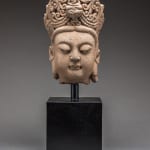Ming Dynasty Bodhisattva Stone Head, 1368 CE - 1644 CE
Stone
31.1 x 21 cm
12 1/4 x 8 1/4 in
12 1/4 x 8 1/4 in
AM.0335
Further images
In Buddhism, bodhisattva is the Sanskrit term for anyone who, motivated by great compassion, has generated bodhicitta, which is a spontaneous wish and a compassionate mind to attain buddhahood for...
In Buddhism, bodhisattva is the Sanskrit term for anyone who, motivated by great compassion, has generated bodhicitta, which is a spontaneous wish and a compassionate mind to attain buddhahood for the benefit of all sentient beings.
According to the above, an ordinary person may decide to take up a course in his or her life that moves into the direction of becoming a Buddha.
After receiving Enlightenment every person may become a Buddha but the difference between a Buddha and a Bodhisattva lies in the fact that a Bodhisattva after having received Enlightenment and after having achieved Buddhahood, returns to the suffering-laden world to assist all sentient beings on their path to Buddhahood.
Bodhisattvas are an extremely popular subject in Buddhist art.
Buddhism was introduced to China from India in the years of the first millennium. This head represents the bodhisattva of mercy, known as Avalokiteshvara (or Guanyin in Chinese). Bodhisattvas were originally depicted as the Buddha’s attendants but increasingly came to be venerated in their own right. Usually dressed in elaborate attire, they were enlightened beings who had chosen to delay their entry into Nirvana to help other sentient beings end the cycle of birth and rebirth. Avalokiteshvara is identifiable by the small seated Buddha that appears in the headdress. This figure was immensely popular in China and it has been estimated that by the Tang period the number of images depicting Avalokiteshvara outnumbered those of the historical Buddha Shakyamuni. Although Buddhist texts do not specify the gender of bodhisattvas, the early examples tend to be male. From the end of the Song dynasty (1279) this trend was reversed and by the Ming period such images are clearly feminine.
Representing a fragment from a larger piece, the head is still striking for the facial expression and the technical virtuosity of the carving. The headdress in particular is an artistic tour de force, with deeply carved foliate trails and a beaded trim. The hair is parted in the centre and frames the face in two smooth bands. The almond shaped eyelids are almost closed in a gesture of meditation but the well-defined lips have the suggestion of a smile- reminding us of this bodhisattva’s approachability and compassion.
According to the above, an ordinary person may decide to take up a course in his or her life that moves into the direction of becoming a Buddha.
After receiving Enlightenment every person may become a Buddha but the difference between a Buddha and a Bodhisattva lies in the fact that a Bodhisattva after having received Enlightenment and after having achieved Buddhahood, returns to the suffering-laden world to assist all sentient beings on their path to Buddhahood.
Bodhisattvas are an extremely popular subject in Buddhist art.
Buddhism was introduced to China from India in the years of the first millennium. This head represents the bodhisattva of mercy, known as Avalokiteshvara (or Guanyin in Chinese). Bodhisattvas were originally depicted as the Buddha’s attendants but increasingly came to be venerated in their own right. Usually dressed in elaborate attire, they were enlightened beings who had chosen to delay their entry into Nirvana to help other sentient beings end the cycle of birth and rebirth. Avalokiteshvara is identifiable by the small seated Buddha that appears in the headdress. This figure was immensely popular in China and it has been estimated that by the Tang period the number of images depicting Avalokiteshvara outnumbered those of the historical Buddha Shakyamuni. Although Buddhist texts do not specify the gender of bodhisattvas, the early examples tend to be male. From the end of the Song dynasty (1279) this trend was reversed and by the Ming period such images are clearly feminine.
Representing a fragment from a larger piece, the head is still striking for the facial expression and the technical virtuosity of the carving. The headdress in particular is an artistic tour de force, with deeply carved foliate trails and a beaded trim. The hair is parted in the centre and frames the face in two smooth bands. The almond shaped eyelids are almost closed in a gesture of meditation but the well-defined lips have the suggestion of a smile- reminding us of this bodhisattva’s approachability and compassion.







